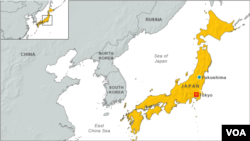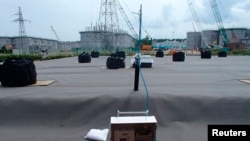SEOUL —
Japan's government has announced it will join efforts to try to contain radioactive water leaking from the damaged Fukushima nuclear plant. Plant operator Tokyo Electric Power (TEPCO) has been struggling to stop the spread of toxic water. But activists argue it is too early to use public funds.
The government says radioactive water building up at the crippled Fukushima Daiichi nuclear plant, and leaking into the ocean, is too serious for it not to get involved.
An official told reporters Wednesday that 300 tons of contaminated water is leaking into the ocean every day. A barrier wall meant to contain toxic groundwater is instead forcing it to the surface where it then drains into the sea.
Prime Minister Shinzo Abe is ordering the Ministry of Economy, Trade, and Industry to work urgently with operator TEPCO to contain the problem.
He said the stability of Fukushima is also a government task, notably the contaminated water problem is one that the Japanese people have a high level of interest in and is an urgent issue to deal with. He says this is not an issue they can let TEPCO take complete responsibility for and they have to deal with this at the national level.
TEPCO has had to continually pump water onto three reactors to cool them since their melt down from the 2011 earthquake and tsunami. If they are not kept cool, they would explode and spread more radiation. But the water used to prevent overheating also becomes radioactive and has to be contained.
Richard Broinowski is a former diplomat and author of the book “Fallout from Fukushima.”
“There's no real end in sight to this problem," he said. "The fact that they've built walls around it to try and contain it with chemicals has been breached and that hasn’t worked. I think there's something like 800,000 tons they expect by 2015, 800,000 tons of highly radioactive water around the cores of these plants.”
Abe is considering using public funds for the cleanup. Japanese media reports say hundreds of millions of dollars could be spent to try to freeze the soil to stop water spreading.
But environmental campaigners say it is too early to be raiding public coffers.
Greenpeace Japan campaigner Hisayo Takada said those who profited from the nuclear plant should be the first to pay up.
“The people who have been involved in the nuclear industry, in making this disaster happen, is not only TEPCO," Takada noted. "Of course, the TEPCO has the most significant responsibility. But, there are other stakeholders such as financial companies or the reactor suppliers, or construction companies. Now, before going into the public money, what the government should do is look into those other stakeholders' responsibility before coming to the public.”
TEPCO has been widely criticized for the failure of the nuclear plant to withstand the 2011 earthquake and tsunami. The company came under further fire after the nuclear meltdowns for its clumsy and defensive response.
It was the worst nuclear disaster in the world since Chernobyl in 1986.









